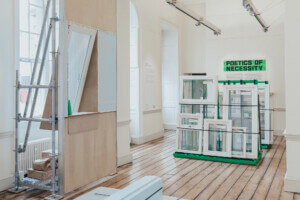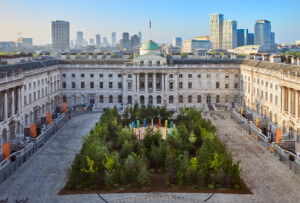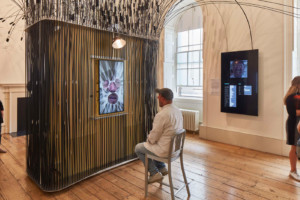While in Chicago for Neocon, The Architect’s Newspaper chatted with Jay Osgerby of London-based studio Barber & Osgerby about their dozens of upcoming and in-the-works projects and design collaborations (including a hints about a top secret project).
For the first ever London Design Biennale, which began September 7 and runs until the 27th, the designers were chosen to create a sculpture for the courtyard of Somerset House. The bienniale—whose theme is Utopia—coincides with the 500th anniversary of Thomas More’s Utopia, his tale of a sailor who describes an island where everything was beautiful and had not yet been disturbed by man.
They interpreted this theme in a way that would link the past and present. Somerset House was once a shipping hub and these days Britain leads the world in offshore wind farms. In the past, the spreading of language and the British empire was driven by wind. Now, wind power provide a sustainable utopian future and the UK garners 5% of its energy through wind turbines. That historied connection between England and the wind informed the design of their steel quasi-machine, quasi-sculpture which has kinetic masts and an anemometer that points to the direction of Utopia—an ever-changing state of mind, not a physical place.
In the pipeline, Barber & Osgerby has a series of projects with design giants that will add to their already impressive line of furniture, lighting, and kitchen and bath products. For the past four years, they have been working on a big project that will be launched this year at Orgatec. All we can tell you is that it involves a painstakingly designed chair.
In collaboration with Ozeki, who creates paper lanterns and originally worked with Isamu Noguchi on his designs, Barber & Osgerby are launching the fifth in a series of lamps that will be premiering at the London design festival in September.
Puzzle, a collection of tiles that can be arranged in countless patterns, is their first experience in working with Italian tile brand Mutina but not their first foray into ceramic tile. Back in 2002, the duo created tiles for Stella McCartney’s New York store that very strongly resembled the 3-D folded paper look that has been trending this year (we saw a lot of it at KBIS back in January).
Additionally, they will be a expanding their collection with Axor to create a new handshower that creates a cascading blade of water—a feature that’s particularly useful for women when shaving their legs. The goal of this addition, as with the majority of their product designs, is to simplify complexity.
The duo’s newest collaboration is with outdoor furniture brand Dedon, whose classic pieces use extruded plastic bands in bright colors (A fun fact that Jay shared: The brand started by making the extruded plastic handles attached to tubs of laundry detergent and segued that into a much more wide range of furnishings). Their line is made of teak from Indonesia that utilizes the brand’s famous plastic as webbing under the seats for extra support and fusion.
When asked if his entire home was outfitted with products by Barber & Osgerby, Jay said yes he owned quite a few pieces, including the loop table, their first product ever, along with flea market finds and antiques from his favorite place to shop, the Deptford Market on the Thames (where Henry VIII had ships made). He admits that most of the items are probably stolen by “geezers” and driven to South London where shoppers unsuspectingly buy the goods.
Barber & Osgerby are also working on a large eight-piece collection with Galerie kreo in Paris, an institution that has also created editions with the Bouroullec brothers, Konstantin Grcic, and many others. For their introductory piece, have created a sculptural three-meter-long table made of oak sourced from a forest in Burgundy. (Next year will bring a group of pieces and a gallery show.) Jay said the experience has been great because they are allowed the opportunity and resources to try things out that will influence the production of pieces in the future.










